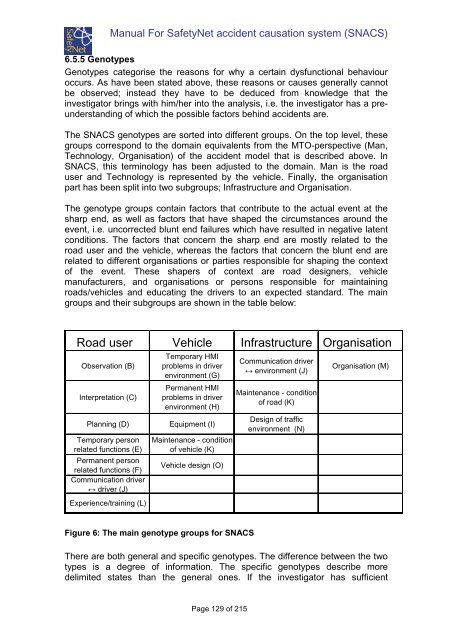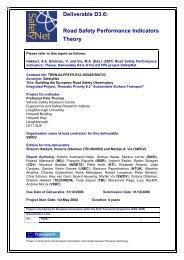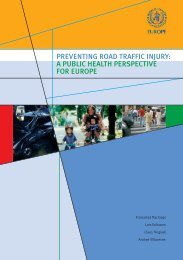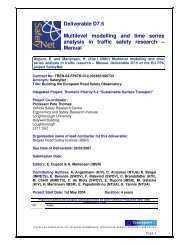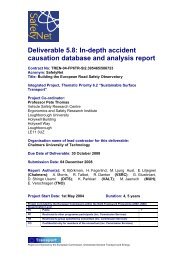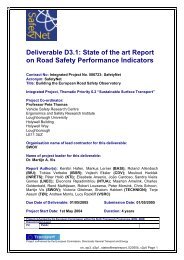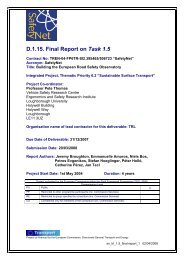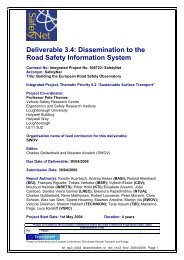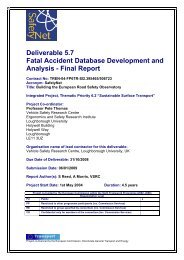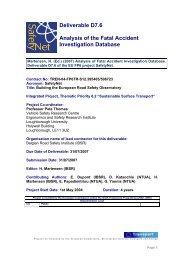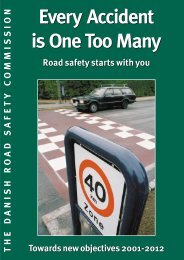Glossary of Data Variables for Fatal and accident causation ... - ERSO
Glossary of Data Variables for Fatal and accident causation ... - ERSO
Glossary of Data Variables for Fatal and accident causation ... - ERSO
You also want an ePaper? Increase the reach of your titles
YUMPU automatically turns print PDFs into web optimized ePapers that Google loves.
Manual For SafetyNet <strong>accident</strong> <strong>causation</strong> system (SNACS)<br />
6.5.5 Genotypes<br />
Genotypes categorise the reasons <strong>for</strong> why a certain dysfunctional behaviour<br />
occurs. As have been stated above, these reasons or causes generally cannot<br />
be observed; instead they have to be deduced from knowledge that the<br />
investigator brings with him/her into the analysis, i.e. the investigator has a preunderst<strong>and</strong>ing<br />
<strong>of</strong> which the possible factors behind <strong>accident</strong>s are.<br />
The SNACS genotypes are sorted into different groups. On the top level, these<br />
groups correspond to the domain equivalents from the MTO-perspective (Man,<br />
Technology, Organisation) <strong>of</strong> the <strong>accident</strong> model that is described above. In<br />
SNACS, this terminology has been adjusted to the domain. Man is the road<br />
user <strong>and</strong> Technology is represented by the vehicle. Finally, the organisation<br />
part has been split into two subgroups; Infrastructure <strong>and</strong> Organisation.<br />
The genotype groups contain factors that contribute to the actual event at the<br />
sharp end, as well as factors that have shaped the circumstances around the<br />
event, i.e. uncorrected blunt end failures which have resulted in negative latent<br />
conditions. The factors that concern the sharp end are mostly related to the<br />
road user <strong>and</strong> the vehicle, whereas the factors that concern the blunt end are<br />
related to different organisations or parties responsible <strong>for</strong> shaping the context<br />
<strong>of</strong> the event. These shapers <strong>of</strong> context are road designers, vehicle<br />
manufacturers, <strong>and</strong> organisations or persons responsible <strong>for</strong> maintaining<br />
roads/vehicles <strong>and</strong> educating the drivers to an expected st<strong>and</strong>ard. The main<br />
groups <strong>and</strong> their subgroups are shown in the table below:<br />
Road user Vehicle Infrastructure Organisation<br />
Observation (B)<br />
Interpretation (C)<br />
Planning (D)<br />
Temporary person<br />
related functions (E)<br />
Permanent person<br />
related functions (F)<br />
Communication driver<br />
↔ driver (J)<br />
Experience/training (L)<br />
Temporary HMI<br />
problems in driver<br />
environment (G)<br />
Permanent HMI<br />
problems in driver<br />
environment (H)<br />
Equipment (I)<br />
Maintenance - condition<br />
<strong>of</strong> vehicle (K)<br />
Vehicle design (O)<br />
Communication driver<br />
↔ environment (J)<br />
Maintenance - condition<br />
<strong>of</strong> road (K)<br />
Design <strong>of</strong> traffic<br />
environment (N)<br />
Organisation (M)<br />
Figure 6: The main genotype groups <strong>for</strong> SNACS<br />
There are both general <strong>and</strong> specific genotypes. The difference between the two<br />
types is a degree <strong>of</strong> in<strong>for</strong>mation. The specific genotypes describe more<br />
delimited states than the general ones. If the investigator has sufficient<br />
Page 129 <strong>of</strong> 215


